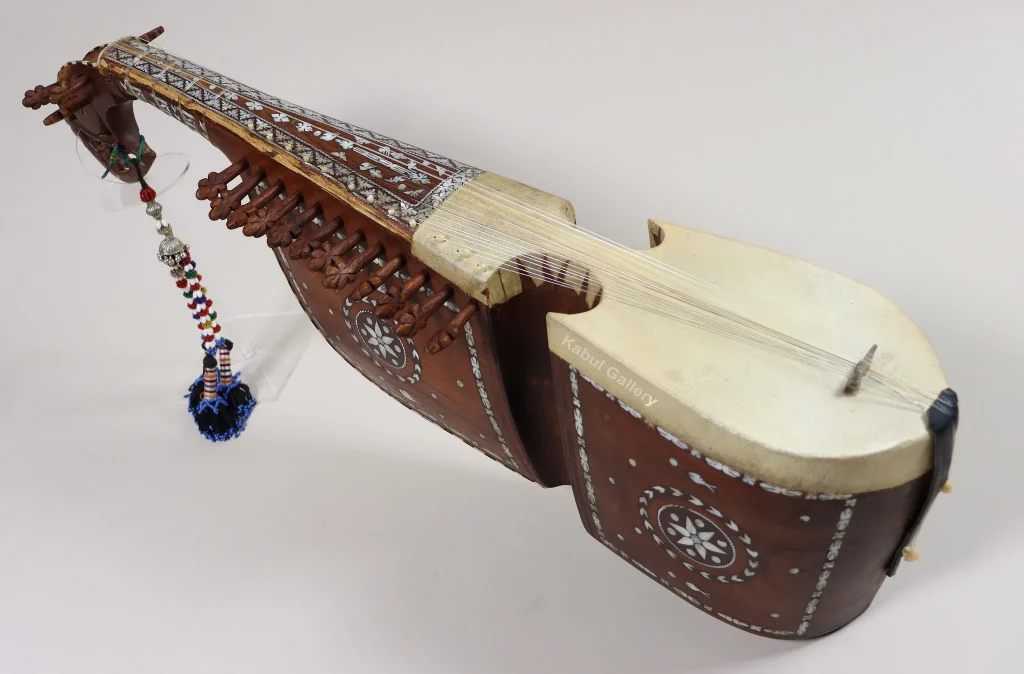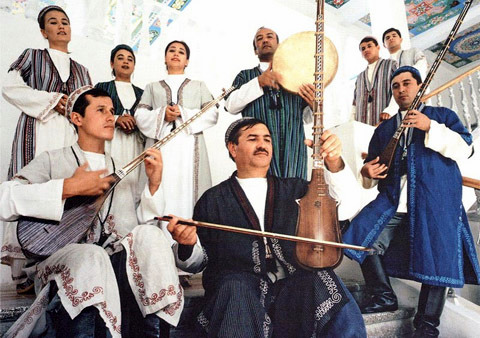
The Turkmen dutar is a long-necked, two-stringed lute distinguished by its pear-shaped resonating body and thin wooden soundboard. Both the body and soundboard are carved from mulberry wood, while the neck is crafted from the dried trunk of an apricot tree. To construct the instrument, the mulberry wood is carefully rounded, hollowed out, and polished to shape the body. The soundboard wood undergoes a drying process—baked for up to 24 hours to eliminate moisture—before being affixed over the hollowed chamber using traditional bone glue. Traditionally tuned a fourth apart, its two strings serve distinct musical functions: the higher-pitched string carries the primary melody, while the lower-pitched string is often muted by the thumb of the playing hand to produce a shifting parallel melody. Alternatively, the lower string may ring open to function as a drone in certain pieces or passages. Believed to descend from ancient Babylonian and Egyptian lutes, the dutar today is primarily used to accompany Turkmen bards known as bagşy (or bakshy). In the south central Ahal region of Turkmenistan, however, dutar players have cultivated a solo instrumental repertoire. Historically passed down orally, this body of music has, in recent decades, seen partial transcription into a modified form of Western notation for pedagogical purposes. Formally sophisticated and largely through-composed, the repertoire still allows space for variation and interpretive flexibility.

In Turkmen music, the term hasap, which literally means account or reckoning, carries a range of other nuanced meanings. In everyday use, one might request a hasap when settling a bill at a restaurant or inquiring about the score of a game. Within musical contexts, hasap denotes various interpretive and structural concepts. Musicians may refer to a particular master’s hasap for a given piece, or more generally to the shared hasap of a composition. Along with related terms such as nusga, forma, and skema, hasap can indicate a skeletal melodic framework that individual performers elaborate through ornamentation and stylistic variation. Comparative transcriptions of extended passages–whether interpreted by multiple dutar players or revisited by the same performer–often reveal consistency in underlying structure, with variation appearing primarily in melodic embellishment, rhythmic phrasing, and the treatment of the lower string.


Turkmen dutar players navigate the dual imperative to both preserve and creatively reinterpret traditional repertoire. To do so, they draw on a repertoire of internalized formulas, compositional schemas, and aesthetic principles to generate new musical material–whether in improvisation or composition. These strategies parallel those found in other music traditions, such as Hindustani music, Persian classical music, and jazz, where deep immersion in a musical system enables spontaneous creativity within established boundaries. Like Persian musicians who internalize the radif through prolonged apprenticeship, Turkmen performers absorb such frameworks, often without formal codification. Turkmen dutar players, however, tend to reapply these principles not just in improvisatory spaces, but within the reinterpretation of the inherited compositions themselves.
This according to “Principles of transmission and collective composition in Turkmen dutar performance” by David Fossum (Analytical approaches to world musics 5/2 [2017] 37 p.; RILM Abstracts with Full Text, 2017-43691) and the entry on the dutar in Musical instruments: A comprehensive dictionary (1964); find it in RILM Music Encyclopedias.
The Turkmen dutar is on UNESCO’s Representative List of the Intangible Cultural Heritage of Humanity.
Below, Oghlan Bakhshi performs the traditional Turkmen song Boy bibi. The video after it, created by UNESCO, is on dutar making and performance.






